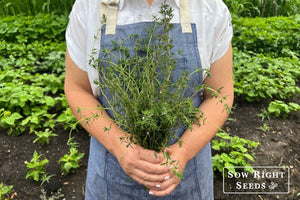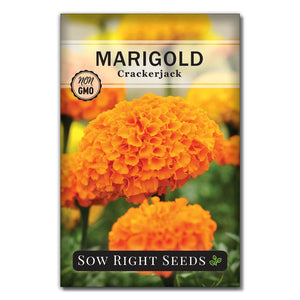How to Outsmart and Get Rid of Japanese Beetles to Protect Your Garden
PestsAargh! Just when your flowers are beautiful and blooming, you notice shiny metallic-green beetles eating everything in sight. Japanese beetles can lay waste to all your gorgeous blooms almost overnight. But the good news is, they won't kill the plant, and you can fight back. We'll cover the lifecycle of the Japanese beetle and share several approaches to add to your arsenal. With these proven tips, you'll be ready to win the war on Japanese beetles.

Japanese Beetle Life Cycle
Understanding the lifecycle of Japanese beetles is key to controlling their population and will help you create a coordinated defense.
Adult
You will first notice Japanese beetles when they start feasting on tender leaves and petals. If you see skeletonized leaves and roses decimated in a day, you might have Japanese beetles. They are easy to identify with their metallic-looking copper and green bodies.
Japanese Beetles will fly around sniffing out food sources and pheromones. They will go after plants that are rotting and have overripe fruit. You can make your yard less attractive by keeping your garden clean. This is the time when you can pick beetles off by hand, cover your plants, and use topical sprays.
Eggs
While the Japanese beetles are feasting and mating, the females are laying eggs. She lays a few eggs at a time in the ground and repeats this process to lay between 40 to 60 eggs. This feasting, mating, and laying eggs cycle usually starts around the end of June and through July.
Larvae
In August and into September, the larvae hatch and feast on roots, usually in lawns and other grassy areas. During this cycle, you can treat the lawn for grubs to kill the larvae. If you have grubs eating your grass roots, you will notice dead spots.
Pupae
As temperatures cool, the larvae crawl deeper into the soil and are harder to eliminate. But then they will come back to the surface in the spring to feed on roots again before pupating. They will then emerge as adult beetles and start the cycle of feasting and mating all over again.

How to Outsmart and Protect Your Garden From Japanese Beetles
Now that you know the Japanese beetle life cycle, you’re ready to tackle how to get rid of these pests.
Handpicking Japanese Beetles
At the feasting and mating stage, your best line of defense is picking off Japanese beetles as fast as possible. The beetles are laying eggs daily and can lay up to 60 eggs each. So, this is the time to disrupt the cycle. Japanese beetles don’t sting or bite, but you still may want to wear gloves. Go out early in the morning before they fly off. They seem to be slow and sleepy at this time of day.
Take a bucket of water and add a few drops of dish soap. Then, shake the leaves or grab beetles and drop them into the bucket of soapy water. Leave the beetles in the bucket for the rest of the day so that they are dead before you dump them out.
If you keep an eye on it and pick off Japanese beetles every day, you can limit their damage and prevent them from breeding and laying eggs. This will reduce the number you have coming back next year.
Vacuum Them Up
This can be a fun task for kids or those who are squeamish about touching bugs. You can use a shop or small cordless vacuum to collect all the Japanese beetles you can see. You'll want to dispose of the beetles once you’ve trapped them in the vacuum.
Japanese Beetle Traps
Beetle traps have their pros and cons. The traps work by attracting the beetles, and then they can’t get out. However, the traps attract more beetles into your yard, and they can be coming from all your neighbors. Japanese beetles can smell up to a mile away! For this reason, traps aren’t recommended. But if you do use them, place them at least 50 feet away from your garden and any plants you want to protect.

Use Neem Oil
Neem oil can be sprayed on plants to kill Japanese beetles. However, it can also be toxic to fish and bees. So apply it early in the morning to lessen the chance of bees eating it. Its chemical compound breaks down fairly quickly during the day.
Cover Your Plants
You can use fabric plant covers to keep Japanese beetles off your flowers and other vulnerable plants. These will keep the beetles from chewing on your beautiful blossoms. You may want to remove the covers during the day to allow pollinators to reach the flowers.
Grow Flowers Japanese Beetles Don’t Like
We know Japanese beetles love to feast on roses, bean leaves, grapes, and other plants. But there are flowers that they don’t like to eat. You’re less likely to lose petals to these munching pests if you grow Coreopsis, California poppy, Forget-Me-Not, Nasturtium, Pansy, and Chrysanthemums.
Succession Plant
The feasting time for Japanese beetles is usually the middle of June through July. With succession planting, you can have flowers blooming at different times to stagger the availability. Plan for some flowers to bloom before the adult beetles are out. Then have another harvest after the Japanese beetles have disappeared.
Companion Plants
Companion planting is helpful for winning all kinds of gardening battles. Pairing up the right plants will produce smells that turn away Japanese beetles. Catnip, garlic, and chives are all known to repel Japanese beetles.
Geraniums are especially helpful in combating Japanese beetles. The bright flower petals are toxic to the beetles, and they’ll be paralyzed for 24 hours after eating them. This will make it easy to gather them up. They will also be unable to get away from birds and other predators that can eat them. Larkspur and chrysanthemums have had mixed results in studies but have been said to have similar effects and are worth planting.

Grub Control
Stopping grubs before they have a chance to hatch can keep Japanese beetles from multiplying. During the larvae and pupating stages, beneficial nematodes, milky spore, and other chemical applications can be applied to lawns and grassy areas. Check with your local Extension Service to see what pesticides are appropriate in your location.
Keep Your Garden Clean and Healthy
Japanese beetles are attracted to overripe fruit and damaged plants. Leaves that have been chewed emit scents that tell the beetles to continue munching. So remove leaves and blooms that have been damaged. Keep your plants healthy with needed nutrients and. consistent watering, as beetles will seek out distressed plants.

Japanese Beetle FAQs
Does squishing Japanese beetles attract more beetles?
No—squishing Japanese beetles does not attract more beetles.
This myth likely started because many insects release distress pheromones when crushed, but Japanese beetles don’t. (Source: https://webdoc.agsci.colostate.edu/bspm/InsectInformation/Talks2019/QAsbeetle.pdf)
In fact, handpicking and squishing is one of the most effective organic control methods, especially early in the season.
What time of year do Japanese beetles appear?
Japanese beetles typically emerge in mid-June through July. This is when they feed, mate, and lay eggs in the soil.
What plants do Japanese beetles eat and what do they avoid?
They love roses, zinnias, grapes, hibiscus, and fruit trees. However, they tend to avoid plants like coreopsis, larkspur, chrysanthemums, and forget-me-nots —making these great choices for beetle-resistant planting.
Do Japanese beetle traps actually work?
Traps do work in that they attract beetles to them. The problem is that they often bring more beetles to your yard than they catch. If you use traps, place them far away from your garden to avoid attracting beetles to your plants.
The sight of Japanese beetles just when your garden is starting to take off can be frustrating. But by understanding their life cycle and using your whole arsenal of methods, you can protect your garden and win the battle against Japanese beetles.
Ready to take action? Try one of the beetle-resistant plants listed above, or start scouting and squishing first thing tomorrow morning. You’ve got this!
👉 Have a go-to tip or plant that keeps beetles at bay? Share it in the comments. We love to hear what’s working in your yard!








There are many kinds of beetles that feed at night. Ground beetles and June Bugs are some that we see here.
What kind of beetle feeds at night. See them in our pool but not on the petals during the day
Mary – Neem oil is not toxic to birds, including hummingbirds.
If I use Neem Oil to control the beetles, will it harm the hummingbirds?
We’ve been in our house for 42 yrs and used to have really bad beetle infestations every year. We tried those traps and must have had every beetle in town come to our yard! So for several years I’ve been diligently hand picking them and last year we had almost none! Really! It takes effort and dedication (and a bit of OCD), we’ll see how it goes this year.
Leave a comment